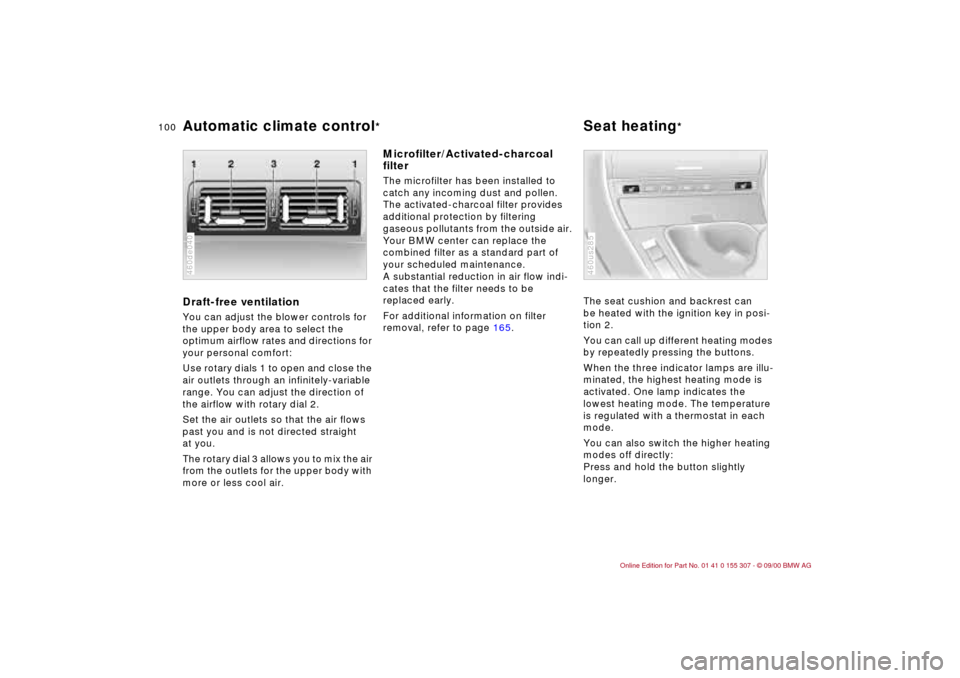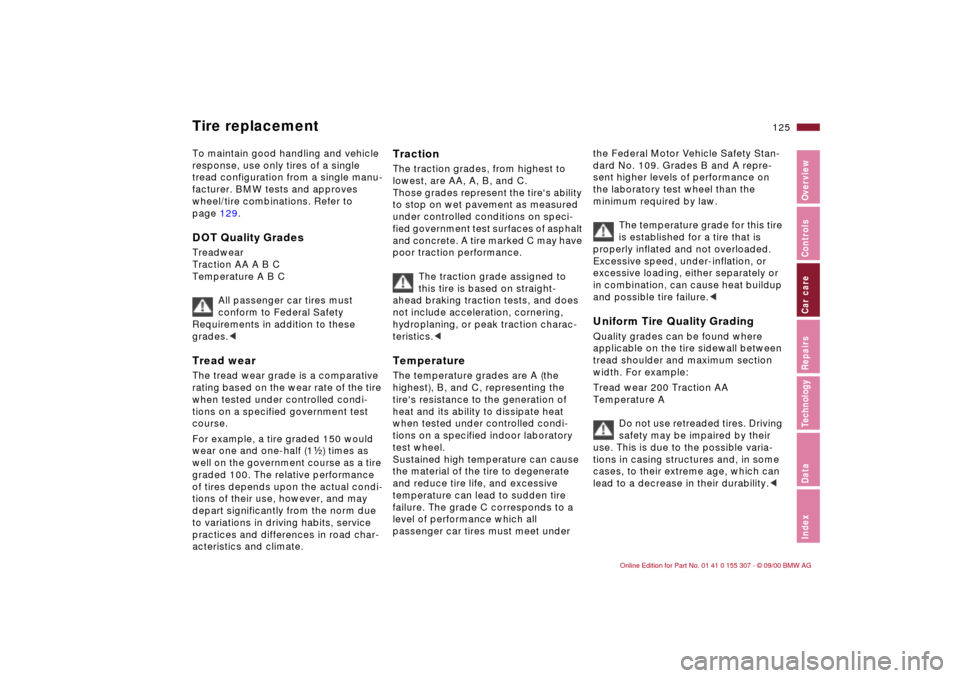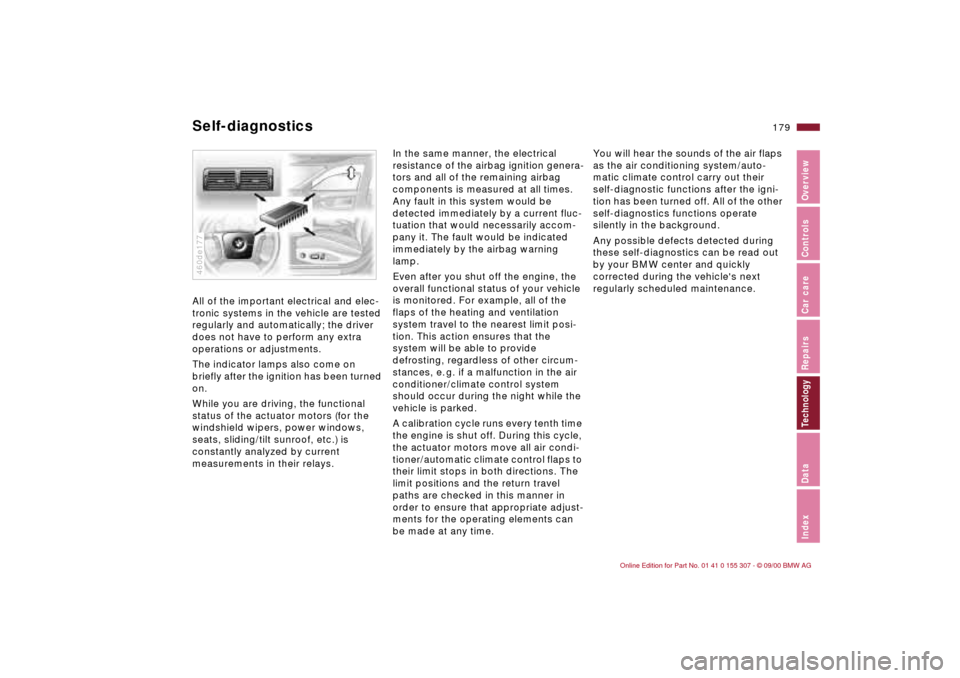2001 BMW 330i TOURING climate control
[x] Cancel search: climate controlPage 100 of 203

100n
Automatic climate control
*
Seat heating
*
Draft-free ventilation You can adjust the blower controls for
the upper body area to select the
optimum airflow rates and directions for
your personal comfort:
Use rotary dials 1 to open and close the
air outlets through an infinitely-variable
range. You can adjust the direction of
the airflow with rotary dial 2.
Set the air outlets so that the air flows
past you and is not directed straight
at you.
The rotary dial 3 allows you to mix the air
from the outlets for the upper body with
more or less cool air.460de040
Microfilter/Activated-charcoal
filterThe microfilter has been installed to
catch any incoming dust and pollen.
The activated-charcoal filter provides
additional protection by filtering
gaseous pollutants from the outside air.
Your BMW center can replace the
combined filter as a standard part of
your scheduled maintenance.
A substantial reduction in air flow indi-
cates that the filter needs to be
replaced early.
For additional information on filter
removal, refer to page 165.The seat cushion and backrest can
be heated with the ignition key in posi-
tion 2.
You can call up different heating modes
by repeatedly pressing the buttons.
When the three indicator lamps are illu-
minated, the highest heating mode is
activated. One lamp indicates the
lowest heating mode. The temperature
is regulated with a thermostat in each
mode.
You can also switch the higher heating
modes off directly:
Press and hold the button slightly
longer.
460us285
Page 125 of 203

125n
IndexDataTechnologyRepairsCar careControlsOverview
To maintain good handling and vehicle
response, use only tires of a single
tread configuration from a single manu-
facturer. BMW tests and approves
wheel/tire combinations. Refer to
page 129.DOT Quality GradesTreadwear
Traction AA A B C
Temperature A B C
All passenger car tires must
conform to Federal Safety
Requirements in addition to these
grades.< Tread wearThe tread wear grade is a comparative
rating based on the wear rate of the tire
when tested under controlled condi-
tions on a specified government test
course.
For example, a tire graded 150 would
wear one and one-half (1g) times as
well on the government course as a tire
graded 100. The relative performance
of tires depends upon the actual condi-
tions of their use, however, and may
depart significantly from the norm due
to variations in driving habits, service
practices and differences in road char-
acteristics and climate.
TractionThe traction grades, from highest to
lowest, are AA, A, B, and C.
Those grades represent the tire's ability
to stop on wet pavement as measured
under controlled conditions on speci-
fied government test surfaces of asphalt
and concrete. A tire marked C may have
poor traction performance.
The traction grade assigned to
this tire is based on straight-
ahead braking traction tests, and does
not include acceleration, cornering,
hydroplaning, or peak traction charac-
teristics.< TemperatureThe temperature grades are A (the
highest), B, and C, representing the
tire's resistance to the generation of
heat and its ability to dissipate heat
when tested under controlled condi-
tions on a specified indoor laboratory
test wheel.
Sustained high temperature can cause
the material of the tire to degenerate
and reduce tire life, and excessive
temperature can lead to sudden tire
failure. The grade C corresponds to a
level of performance which all
passenger car tires must meet under
the Federal Motor Vehicle Safety Stan-
dard No. 109. Grades B and A repre-
sent higher levels of performance on
the laboratory test wheel than the
minimum required by law.
The temperature grade for this tire
is established for a tire that is
properly inflated and not overloaded.
Excessive speed, under-inflation, or
excessive loading, either separately or
in combination, can cause heat buildup
and possible tire failure.< Uniform Tire Quality Grading Quality grades can be found where
applicable on the tire sidewall between
tread shoulder and maximum section
width. For example:
Tread wear 200 Traction AA
Temperature A
Do not use retreaded tires. Driving
safety may be impaired by their
use. This is due to the possible varia-
tions in casing structures and, in some
cases, to their extreme age, which can
lead to a decrease in their durability.<
Tire replacement
Page 179 of 203

179n
IndexDataTechnologyRepairsCar careControlsOverview
Self-diagnostics All of the important electrical and elec-
tronic systems in the vehicle are tested
regularly and automatically; the driver
does not have to perform any extra
operations or adjustments.
The indicator lamps also come on
briefly after the ignition has been turned
on.
While you are driving, the functional
status of the actuator motors (for the
windshield wipers, power windows,
seats, sliding/tilt sunroof, etc.) is
constantly analyzed by current
measurements in their relays.460de177
In the same manner, the electrical
resistance of the airbag ignition genera-
tors and all of the remaining airbag
components is measured at all times.
Any fault in this system would be
detected immediately by a current fluc-
tuation that would necessarily accom-
pany it. The fault would be indicated
immediately by the airbag warning
lamp.
Even after you shut off the engine, the
overall functional status of your vehicle
is monitored. For example, all of the
flaps of the heating and ventilation
system travel to the nearest limit posi-
tion. This action ensures that the
system will be able to provide
defrosting, regardless of other circum-
stances, e. g. if a malfunction in the air
conditioner/climate control system
should occur during the night while the
vehicle is parked.
A calibration cycle runs every tenth time
the engine is shut off. During this cycle,
the actuator motors move all air condi-
tioner/automatic climate control flaps to
their limit stops in both directions. The
limit positions and the return travel
paths are checked in this manner in
order to ensure that appropriate adjust-
ments for the operating elements can
be made at any time.You will hear the sounds of the air flaps
as the air conditioning system/auto-
matic climate control carry out their
self-diagnostic functions after the igni-
tion has been turned off. All of the other
self-diagnostics functions operate
silently in the background.
Any possible defects detected during
these self-diagnostics can be read out
by your BMW center and quickly
corrected during the vehicle's next
regularly scheduled maintenance.
Page 192 of 203

Everything from A to ZA
ABS (Antilock Brake
System)22,116
Accessories6
Activated-charcoal
filter100,165
Adaptive Transmission
Control (ATC)65,173
Adding engine oil135
Adding washer
fluid134,187
Adjust
backrest47
steering wheel50
temperature92
thigh support area48
Air conditioner90
Air distribution92,98
Air nozzles90
Air outlets96
ventilation90,96
Air pressure124
Air supply92,99
Airbags21,58,147,172
Alarm system41
Antenna123
Antenna Diversity174
Antifreeze137
radiator121
Antilock Brake System
(ABS)22,116
Anti-theft alarm system41
Aquaplaning115,124 Armrest102
ASC+T (Automatic Stability
Control plus
Traction)22,173
Ashtray104
ATC (Adaptive Transmission
Control)65,173
Attaching vacuum
cleaner104
AUC (Automatic climate
control)96
Automatic car washes141
Automatic climate
control96
remove condensation from
the windows98
Automatic cruise control71
Automatic dimming, interior
rearview mirror52
Automatic Stability Control
plus Traction
(ASC+T)22,173
Automatic transmission21
Automatic transmission with
Steptronic65
Automatic washer
rear window69
windshield69
Average consumption77
Average speed77
Axle loads186
B
Backrest, adjusting47
Backup lamps64
bulb replacement156
Battery162,188
capacity188
charging164
discharged167
removal and
installation163
Battery charge current20
Battery safety terminal163
Belts53
Beverage holder102
Blower92,99
BMW High Performance
Synthetic Oils136
BMW sports seat48
Bore184
Brake
fluid138
hydraulic system20
pads22
Brake lamps
bulb replacement156
Brake system118
faults120
Break-in procedure114
Bulb replacement153
Bulbs and lamps153
C
California Proposition
65 Warning148
Capacities187
Car Memory52
Car radio123
reception174
refer also to the separate
Owner's Manual
Car telephone103
Car vacuum cleaner,
connecting104
Car wash141
Care
upholstery145
vehicle exterior142
vehicle finish143
vehicle interior144
wool velour145
Cargo loading110
Catalytic converter115
CBC (Cornering Brake
Control)21,117
Cellular phone123
refer to the separate
Owner's Manual
Center armrest102
Center (high-mount) brake
lamp157
Central locking system34
button38
Changing a tire159